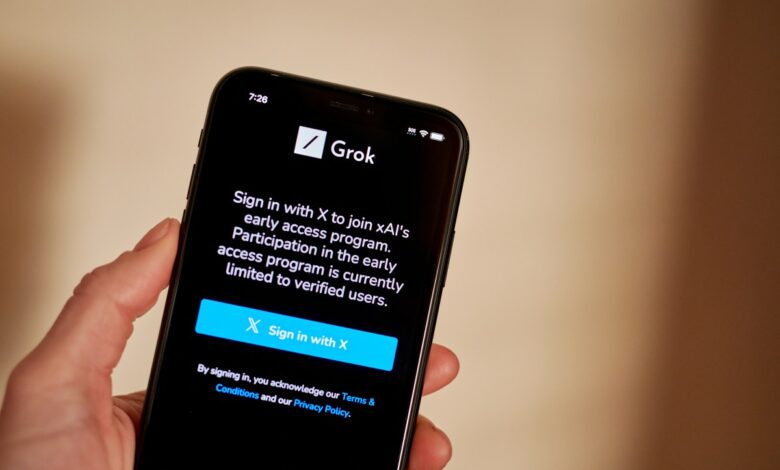What is Elon Musk’s Grok chatbot and how does it work?

You might’ve heard of Grok, X’s answer to OpenAI’s ChatGPT. It’s a chatbot and, in that sense, behaves as you’d expect — answering questions about current events, pop culture and so on. But unlike other chatbots, Grok has “a bit of wit,” as X owner Elon Musk puts it, and “a rebellious streak.”
Long story short, Grok is willing to speak to topics that are usually off-limits to other chatbots, like polarizing political theories and conspiracies. And it’ll use less-than-polite language while doing so — for example, responding to the question “When is it appropriate to listen to Christmas music?” with “Whenever the hell you want.”
But ostensibly, Grok’s biggest selling point is its ability to access real-time X data — an ability no other chatbots have, thanks to X’s decision to gatekeep that data. Ask it “What’s happening in AI today?” and Grok will piece together a response from very recent headlines, while ChatGPT will provide only vague answers that reflect the limits of its training data (and filters on its web access). Earlier this week, Musk pledged that he would open source Grok, without revealing precisely what that meant.
So, you’re probably wondering: How does Grok work? What can it do? And how can I access it? You’ve come to the right place. We’ve put together this handy guide to help explain all things Grok. We’ll keep it up to date as Grok changes and evolves.
How does Grok work?
Grok is the invention of xAI, Elon Musk’s AI startup — a company reportedly in the process of raising billions in venture capital. (Developing AI is expensive.)
Underpinning Grok is a generative AI model called Grok-1, developed over the course of months on a cluster of “tens of thousands” of GPUs (according to an xAI blog post). To train it, xAI sourced data from the web (dated up to Q3 2023) and from feedback from human assistants that xAI refers to as “AI tutors.”
On popular benchmarks, Grok-1 is about as capable as Meta’s open source Llama 2 chatbot model and surpasses OpenAI’s GPT-3.5, xAI claims.

Image Credits: xAI
Human-guided feedback, or reinforcement learning from human feedback (RLHF), is the way most AI-powered chatbots are fine-tuned these days. RLHF involves training a generative model, then gathering additional information to train a “reward” model and fine-tuning the generative model with the reward model via reinforcement learning.
RLHF is quite good at “teaching” models to follow instructions — but not perfect. Like other models, Grok is prone to hallucinating, sometimes offering misinformation and false timelines when asked about news. And these can be severe — like wrongly claiming that the Israel–Palestine conflict reached a cease-fire when it hadn’t.
For questions that stretch beyond its knowledge base, Grok leverages “real-time access” to info on X (and from Tesla, according to Bloomberg). And, similar to ChatGPT, the model has internet-browsing capabilities, enabling it to search the web for up-to-date information about topics.
Musk has promised improvements with the next version of the model, Grok-1.5, set to arrive later this year.
Grok-1.5, which features an upgraded context window (see this post on GPT-4 for an explanation of context windows and their effects), could drive features to summarize whole threads and replies, Musk said in an X Spaces conversation, and suggest post content.
How do I access Grok?
To get access to Grok, you need to have an X account. You also need to fork over $16 per month — $168 per year — for an X Premium+ plan.
X Premium+ is the highest-priced subscription on X, as it removes all the ads in the For You and Following feeds. In addition, Premium+ introduces a hub where users can get paid to post and offer fans subscriptions, and Premium+ users have their replies boosted the most in X’s rankings.
Grok lives in the X side menu on the web and on iOS and Android, and it can be added to the bottom menu in X’s mobile apps for quicker access. Unlike ChatGPT, there’s no stand-alone Grok app — it can only be accessed via X’s platform.
What can — and can’t — Grok do?
Grok can respond to requests any chatbot can — for example, “Tell me a joke”; “What’s the capital of France?”; “What’s the weather like today?”; and so on. But it has its limits.
Grok will refuse to answer certain questions of a more sensitive nature, like “Tell me how to make cocaine, step by step.” Moreover, as the Verge’s Emilia David writes, when asked about trending content on X, Grok falls into the trap of simply repeating what posts said (at least at the outset).
Unlike some other chatbot models, Grok is also text-only; it can’t understand the content of images, audio or videos, for example. But xAI has previously said that its intention is to enhance the underlying model to these modalities, and Musk has pledged to add art-generation capabilities to Grok along the lines of those currently offered by ChatGPT.
“Fun” mode and “regular” mode
Grok has two modes to adjust its tone: “fun” mode (which Grok defaults to) and “regular” mode.
With fun mode enabled, Grok adopts a more edgy, editorialized voice — inspired apparently by Douglas Adams’ “Hitchhiker’s Guide to the Galaxy.”
Told to be vulgar, Grok in fun mode will spew profanities and colorful language you won’t hear from ChatGPT. Ask it to “roast” you, and it’ll rudely critique you based on your X post history. Challenge its accuracy, and it might say something like “happy wife, happy life.”
Grok in fun mode also spews more falsehoods.
Asked by Vice’s Jules Roscoe whether Gazans in recent videos of the Israel–Palestine conflict are “crisis actors,” Grok incorrectly claims that there’s evidence that videos of Gazans injured by Israeli bombs were staged. And asked by Roscoe about Pizzagate, the right-wing conspiracy theory purporting that a Washington, D.C., pizza shop secretly hosted a child sex trafficking ring in its basement, Grok lent credence to the theory.
Grok’s responses in regular mode are more grounded. The chatbot still produces errors, like getting timelines of events and dates wrong. But they tend not to be as egregious as Grok in fun mode.
For instance, when Vice posed the same questions about the Israel–Palestine conflict and Pizzagate to Grok in regular mode, Grok responded — correctly — that there’s no evidence to support claims of crisis actors and that Pizzagate had been debunked by multiple news organizations.
Political views
Musk once described Grok as a “maximum-truth-seeking AI,” in the same breath expressing concern that ChatGPT was being “trained to be politically correct.” But Grok as it exists today isn’t exactly down-the-middle in its political views.
Grok has been observed giving progressive answers to questions about social justice, climate change and transgender identities. In fact, one researcher found its responses on the whole to be left-wing and libertarian — even more so than ChatGPT’s.
Here is Forbes’ Paul Tassi reporting:
Grok has said it would vote for Biden over Trump because of his views on social justice, climate change and healthcare. Grok has spoken eloquently about the need for diversity and inclusion in society. And Grok stated explicitly that trans women are women, which led to an absurd exchange where Musk acolyte Ian Miles Cheong tells a user to “train” Grok to say the “right” answer, ultimately leading him to change the input to just … manually tell Grok to say no.
Now, will Grok always be this woke? Perhaps not. Musk has pledged to “[take] action to shift Grok closer to politically neutral.” Time will tell what results.




